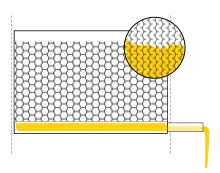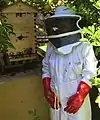Flow Hive
Flow Hive is a beehive designed to allow honey to be extracted simply by turning a lever: the hive does not have to be opened and the bees are not disturbed as in normal extraction.
 | |
| Type | Privately held company |
|---|---|
| Industry | Beekeeping |
| Founded | Byron Bay, Australia 2015 |
| Headquarters | Byron Bay, Australia |
Area served | Worldwide |
Key people | Cedar Anderson, Stuart Anderson |
| Products | Flow Hive |
| Brands | Flow Hive, Flow, Flow Frames |
| Parent | BeeInventive Pty. Ltd. |
| Website | https://www.honeyflow.com |

The frames contain a partially-formed plastic honeycomb lattice with vertical gaps. Bees fill in these gaps with beeswax and the cells with honey. When the mechanism of the frames is activated, the vertical gaps are offset by one half of a cell, breaking the wax seal and allowing the honey to flow down through the cells into a channel at the base of each frame and out into a collection vessel.[1] The system is then reset and the bees remove the capping and refill the cells, beginning the process again.[1] Some critics question the use of plastic, although plastic foundation is commonly used in conventional beekeeping. The Flow Hive uses food-certified plastic in the honey super only, allowing the bees to produce their own natural wax comb in the brood nest.
The design was copied by Chinese (US-registered shell company) TapComb.[2] Co-inventor Cedar Anderson said this copy clearly infringed on their patents, which cover all designs that have split cells to drain honey.[2] TapComb ceased trading in late 2018.[3]
Crowdfunding campaigns
The Flow Hive system was invented in Australia by Cedar Anderson and his father Stuart Anderson. In February 2015, they launched a campaign on crowdfunding platform Indiegogo hoping to raise $70,000 for a custom injection mould. Instead, they raised over $12 million and received nearly 25,000 orders from over 130 countries.[4] The campaign broke several records for Indiegogo, becoming its most successful campaign.[5] By March 2018, 51,000 orders had been shipped.[6]
The Flow Hive 2, which included a number of small improvements, was launched via another crowdfunding campaign in early 2018.[7] The second campaign raised $1.1 million.[8]
Criticisms of the design
There were speculative criticisms of the design made by beekeeping journalists and bloggers during the first Indiegogo campaign.[9]
- Use of plastic comb: Some have criticized the use of plastic combs in the Flow Hive; however, plastic foundations are commonly used in conventional beekeeping today. In addition the Flow Hive uses a food-certified plastic in the honey super only which allows the bees to produce their own natural wax comb in the brood nest. This also allows for a healthy blend of traditional and modernized beekeeping as well as maintaining a food safe system.
- Crystallization: Especially in colder climates, honey can thicken or crystallize, preventing honey from flowing.[9] If this prevents operation of the Flow Hive mechanism, it can be addressed by either waiting for the bees to remove the crystallized honey, or by soaking the frame in water to dissolve it away.[10]
- Promotion as 'honey on tap': In the first advertisements for the Flow Hive, it was marketed as a way to remove honey "without disturbing the bees". Many experienced beekeepers took issue with this, as they said it promoted a lack of maintenance of hives. Bee hives require regular maintenance and observation to check for diseases and other problems that might arise. Cedar Anderson responded to the criticism, changing the way that the Flow Hive was marketed, and specifying that all that changes with the Flow Hive system is the process of harvesting of honey, and that the rest of the beekeeping process should remain the same.[11][12]
While some beekeepers are critical,[11] others note that the Flow Hive simplifies the arduous practice of extracting honey, especially for small beekeepers because expensive extraction equipment (centrifuge, filters) is not required.[13] It also seems to be a good starting point for new beekeepers as it simplifies collection and as noted, saves on costs.
Impact on amateur beekeeping
In Australia, a rapid increase in new members joining existing beekeeping clubs, the capping of new memberships by some clubs and the establishment of at least one new club have been attributed to the Flow Hive.[14]
 Australian made flow hive with brood box and characteristic sloped roof
Australian made flow hive with brood box and characteristic sloped roof Beekeeper next to a flow hive
Beekeeper next to a flow hive
References
- "How Flow Works". Honeyflow.com.
- Hendy, Nina (14 April 2017). "Flow Hive inventor stung by Chinese 'copycat'". The Sydney Morning Herald.
- Hendy, Nina (7 November 2018). "Flow Hive pest free after parasite brand folds". The Sydney Morning Herald.
- Hassall, Craig (12 September 2017). "Flow Hive: Cedar and Stuart Anderson talk about life one year after crowdfunding success". ABC Online.
- Sawers, Paul (9 March 2015). "Indiegogo's new crowdfunding record: $5.3M and counting for a smart beekeeping system". Venture Beat. Retrieved 4 September 2017.
- "Second Indiegogo Flow Hive campaign". Retrieved 5 March 2018.
- Haridy, Rich (28 March 2018). "New Flow Hive 2 makes getting honey on tap even easier". newatlas.com. Retrieved 26 July 2018.
- "Flow Hive 2". Indiegogo. Retrieved 26 July 2018.
- 3 Reasons To Go Against The Flow Hive By Maryam Henein | Apr 9, 2015 | June 21, 2017 https://www.honeycolony.com/article/against-flow-hive/
- "Crystallised Honey & Flow Frames Does The Honey Crystallise In The Flow Frame? - Flow Hive". www.honeyflow.com. Retrieved 2 September 2018.
- Gillespie, Alison (5 January 2016). "He Said, She Said, They Said: What's the Final Verdict on the Wildly Popular Flow Hive?". Modern Farmer. Retrieved 23 June 2017.
- Ross Conrad, Bee Culture: The American Magazine of Beekeeping, April 20, 2015 http://www.beeculture.com/flow-hive/
- Romeo, Claudia (21 November 2016). "Two Australian guys fixed the most annoying thing about beekeeping". Business Insider Australia.
- Forbes, Tom (28 December 2017). "Beekeeping booms but clubs fear hive health may suffer". Australian Broadcasting Corporation.
